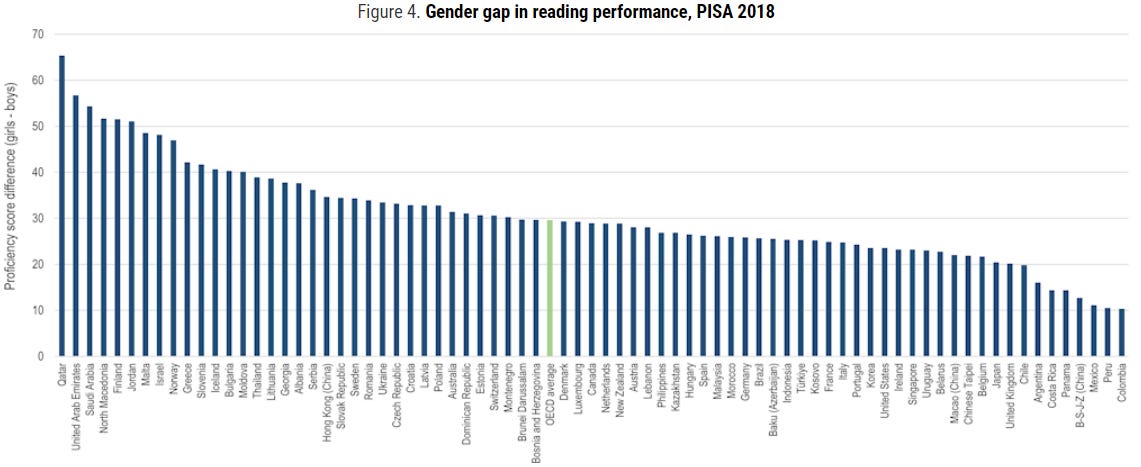I’ve been out and about a lot in recent weeks talking to policymakers at all levels, from individual schools and universities, state legislators, national politicians and international bodies including, just last week, the OECD. My message to them has been: many boys and men are struggling and you should do more about that. They should do more about it just because if people need help, the point of policy is to help them.
But there is more at stake here. The failure to address the real problems of boys and men creates a dangerous vacuum in our culture and politics, one that irresponsible parties are able to exploit. In Of Boys and Men I quote a line from Daniel Schwammenthal, director of the American Jewish Committee’s Transatlantic Institute:
The iron rule of politics is that if there are real problems in society and responsible parties don’t deal with them, the irresponsible parties will jump on them.
I think that’s absolutely right, and that it applies very strongly to the issues being faced by boys and men. I wrote last time about the failure of the CDC to even acknowledge the massive and rising gender gap in suicide rates. But there are many examples of this neglect, including the failure of the Gender Policy Council in the White House to address a single gender gap where boys and men are at a disadvantage. The Council was created in 2021 by President Biden as a successor to the previous Council on Women and Girls, which had been abolished by Donald Trump. As I write in Of Boys and Men:
While the name changed, the mission did not. The formal charge of the new Council is ‘to guide and coordinate government policy that impacts women and girls.’ In October 2021, the Council published a National Strategy on Gender equity and equality, the first in U.S. history. The strategy is entirely asymmetric. No gender inequalities related to boys or men are addressed. The fact that women now outnumber men in college is noted, but only in order to highlight the fact that women hold more student debt than men. This is absurd. It is like complaining that men pay more income tax because they earn more. There is no mention at all in the strategy of the sizable gender gaps in favor of girls in K–12 education. The need for reform of school discipline policies to help Black girls is emphasized, but there is no mention of the specific challenges of Black boys (even though they are twice as likely as Black girls to be suspended or expelled). The goal of increasing access to health insurance for women is highlighted, but nothing is said about the fact that men are at a higher risk of being uninsured than women (15% v. 11%). I could go on, but you get the picture.
Missed opportunities
But it’s not just the White House. The monocular vision of institutions on gender gaps is the rule rather than the exception. In preparation for my visit to the OECD, I was delighted to see a recent report on education, titled, Gender, Education and Skills: The Persistence of Gender Gaps in Education and Skills. I was a bit less delighted by the end.
First the good news: the report does an excellent good job of setting out the facts. The overall picture is of a large gender gap in education in favor of girls and women. For example, girls are ahead of boys in reading skills at the age of 15 across OECD countries:
The OECD average gap in reading is 30 points, and the gender gap is statistically significant at the 5% level in every nation (that’s what the dark blue means). In every country, the reading gap between boys and girls is more than 10 percentage points.
In math the story is a bit more complex. The OECD average gap in math is five points, in favor of boys. (Note the change in length of the the vertical axis, from 70 to 30). There are some nations with a statistically significant gap in favor or girls, but more nations with a gap in favor of boys:
There is a math gap in favor of boys of more than 10 points in just 10 countries.
In science the gender gap across OECD countries is just 2 percentage points, in favor of girls. (Notably there are wide gaps in favor of girls in the Middle East on this front):
Given these gaps in secondary education, it is not surprising to see a very wide gender gap in post-secondary education. Among adults aged 25-34, the gap in tertiary education for all OECD nations is 13 percentage points (54% for women compared to 41% for men):
So far, so good. The overall picture is indeed of wide and persistent gender gaps.
But the report authors then proceed to entirely ignore all the gender gaps where girls and women are ahead of boys and men, and focus only on those few that run the other way, such as the “under-representation of girls among high-performing students in mathematics” and the fact that at post-secondary level, women are “under-represented in the broad field of science, technology, engineering and mathematics.” There is also a discussion of the modest numeracy gap in favor of men among adults.
The chapter on policy implications is silent on gender gaps disfavoring boys and men, while setting out arguments for:
“Concerted efforts by parents, teachers and employers to become more aware of their own conscious or unconscious biases”
“Help students, particularly girls, overcome their anxiety towards mathematics and their lack of confidence in their STEM abilities.”
“Improving the participation of girls in more mathematical and technological activities in which there is now a predominance of boys.”
“Get girls more interested in mathematics and science, and develop numeracy skills, and to encourage boys to read more would be to remove the gender bias and stereotypes in curricula.”
“Promoting early work experience through education programs and apprenticeships could encourage women, particularly those who successfully completed STEM-related studies, to work in scientific fields”
“Bridge the gender gap in numeracy proficiency at university and in adult life... Mathematics camps can be organized targeting women.
“National measures should be introduced to reduce wage disparities between men and women.”
Of course these are all good and important goals. But coming at the end of a report providing overwhelming evidence that when it comes to education, the biggest gender gaps are clearly in the other direction, it borders on the absurd. The OECD authors have a view of gender inequality that, by definition, can only run one way.
As they write:
Societies are most creative and capable when they encourage all members to invest in their own future and then participate fully in the life of the community. How much harder it is to weather, let alone overcome, these crises if girls and women remain – or are left – on the sidelines.
Agreed. But there is simply no evidence in the document that girls and women are on the sidelines when it comes to education, which is its subject. This makes for a very weak report against its own stated goal. As Francisco Ferreira, Amartya Sen Chair in Inequality Studies at the London School of economics, commenting on international education gaps says:
There is now wide consensus that gender inequalities are unfair, and lead to wasted human potential. That remains true when the disadvantaged are boys, as well as girls.
The OECD and similar institutions are missing a huge opportunity to show boys and men that they:
Have noticed the gaps
Care about the gaps
Have ideas on how to fix the gaps
Politics and the internet both abhor a vacuum
Some of the policy types I’ve spoken to say they are afraid that acknowledging the problems of boys and men will give fuel to reactionaries, either online or at the ballot box.
This is not just wrong, it is the opposite of the truth.
Failing to acknowledge and tackle the problems of boys and men, when they are real and obvious, creates the conditions which reactionaries can exploit.
Take this claim, for example:
I think that men’s issues are largely overlooked. The people in charge of the world pretend to care, but when somebody who’s championing men’s issues like myself comes forward and finally manages to garner huge percentiles of the public support, I’m silenced. So they’re not really interested in men’s issues and there’s a lot of young men growing up today that feel very disaffected, they feel invisible.
If we think the “people in charge of the world” are organizations like the OECD, the White House, the UN, and so on, this statement has more than a ring of truth to it. Maybe you already know who said it, but if not, it was Andrew Tate, the internet influencer who has been arrested in Romania for alleged rape and human trafficking. (If you don’t know who Tate is, read one of my articles on him here or here).
Here’s the thing: Tate sounds very far from crazy when he says things like this. Let alone the much more professorial claims of scholars like Jordan Peterson, or even the culture war rhetoric of Sen. Josh Hawley.
Straightforwardly addressing the issues faced by boys and men would take the issue away from the culture warriors and put it in the hands of the policy wonks. I don’t know about you, but I’d much rather that. I’ve said quite a few times that one of my goals is to make the issues of boys and men much more boring, by bringing them into mainstream institutions.
The title of this post, “Into the vacuum demons pour” was adapted from a line by Richard Rohr, the much loved Franciscan writer and teacher, picked up in a conversation with Krista Tippett, host of the podcast On Being:
When positive masculine energy is not modeled from father to son, it creates a vacuum in the souls of men, and into that vacuum demons pour.
I think something similar goes on at a social and cultural level too. When establishment institutions fail to address the problems of boys and men, it leaves a vacuum, into which the demons of reaction, rage, misogyny then pour.









I don’t think these observations happens in a vacuum.
Recently I heard a podcaster stating that a difference between women and men is that in many cases women act covertly whereas men act overtly.
I think this is also the case on the subject of power and agression. Women - with superior social skills - wield power indirectly by working on the cultural narratives. Agression is done indirectly by innuendo, libel and gossip not to mention amplification and exaggeration of the misdeeds of their foes as well as minimizing their foes’ good deeds.
Women wield way more power over the world than we give them credit for. And way more than what they will take responsibility for.
A small fraction of women see men as their foes and have successfully mobilized the majority into beliving that narrative.
It is not risk-free to go against the powers that be. Neither against overt male power or covert female power. Either case there may be repercussions.
As a society, we're never going to help people who we see as toxic and privileged. Saying “You should help men or they’ll hurt you” is not going to change that narrative.